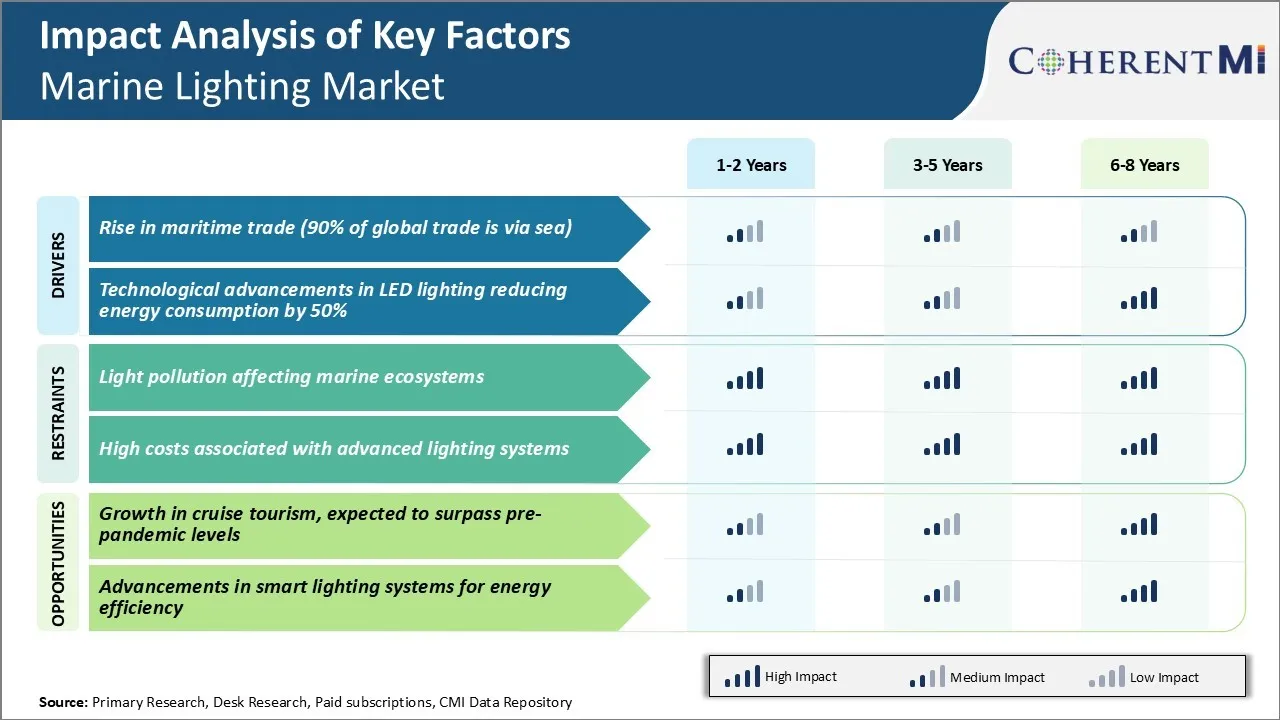Marine Lighting Market Trends
Market Driver - Rise in Maritime Trade (90% of Global Trade is Via Sea)
With over 90% of global trade being transported by sea, maritime trade has seen tremendous growth over the past few decades. Cargo volumes have increased manifold as manufacturing shifted to developing countries and worldwide demand for goods increased.
As international commerce expanded across new trade routes, the number of commercial ships plying the oceans also surged multifold. Marine lighting market players responded to this rise by developing more durable and energy-efficient lighting solutions for ship decks, cargo holds and passenger areas.
Light emitting diode (LED) lights which provide sharp illumination with lesser energy consumption compared to traditional halogen lamps have become widely popular. Ship owners are also outfitting their fleets with modernized lighting during refits and retrofits to cut down fuel costs and meet new IMO regulations.
Port authorities have augmented quay-side lighting and installed navigation aids powered by solar panels at emerging destinations to facilitate round the clock cargo delivery. This boosted commercial maritime traffic and generated higher demand for specialized products within the marine lighting market.
Market Driver - Technological Advancements in LED Lighting Reducing Energy Consumption
LED lights have revolutionized lighting technology with numerous advantages over older lighting sources. Continuous improvements through focused R&D have made LED lights a preferred choice for marine lighting applications today. Ship owners benefit greatly from LED lights that last 6-10 times longer than traditional incandescent bulbs or fluorescent tubes with minimal maintenance.
Newbuilds specify only LED lights to trim electricity requirements substantially from day one of operations. Advanced chip-on-board and modular LED light fixtures simplify installation and replacement at sea. Wireless controls and occupancy sensors linked to LEDs through mobile apps help crews manage power usage efficiently. Their longevity negates frequent lamp changes in hazardous enclosed cargo holds and engine rooms.
Overall, LED marine lamps meeting latest international certifications have emerged as the go-to solution for sustainable and cost-effective lighting. This continues to drive growth of the marine lighting market.

Market Challenge - Light Pollution Affecting Marine Ecosystems
One of the key challenges currently faced in the marine lighting market is light pollution affecting sensitive marine ecosystems. Artificial lighting from ports, cruise ships, and coastal cities has disrupted natural nighttime lighting conditions that many marine species rely on.
Similarly, certain fish, shrimp, and plant species have evolved to use natural light cycles to communicate, feed and protect themselves from predators. Exposure to artificial night lights disrupts these behaviors and makes some species more vulnerable. Environmental groups are raising awareness about this issue, and regulations in certain areas now mandate the use of lighting fixtures that minimize light scattering into the night sky.
Marine lighting market players will need to further innovate fixture designs and light sources that minimize light pollution impact. They will also focus on meeting performance needs for nighttime navigation and operations.
Market Opportunity - Potential for Growth in Cruise Tourism
With an expected growth in cruise tourism, surpassing pre-pandemic levels, there are promising opportunities for the marine lighting market. After multiple years of suspension amid the COVID-19 pandemic, the cruise industry is witnessing a strong revival in bookings for 2023 and beyond. Leading cruise line operators have announced expansion plans involving new ship launches that will drive additional demand for various marine lighting products.
Marine lighting is essential for cruise ships to ensure occupational health and safety of crew members during nighttime operations and maintenance work. There is also a need for decorative lighting and illuminated signage to enhance the nighttime ambiance and experience for passengers. Leading marine lighting manufacturers can expect renewed interest from cruise lines seeking to outfit new ships as well as upgrade existing fleets.
Companies well-positioned in the marine lighting market stand to gain from the cruise industry's comeback in the coming years. Targeted marketing highlighting lighting solutions that improve operational efficiency and passenger experience could help companies secure additional contracts.